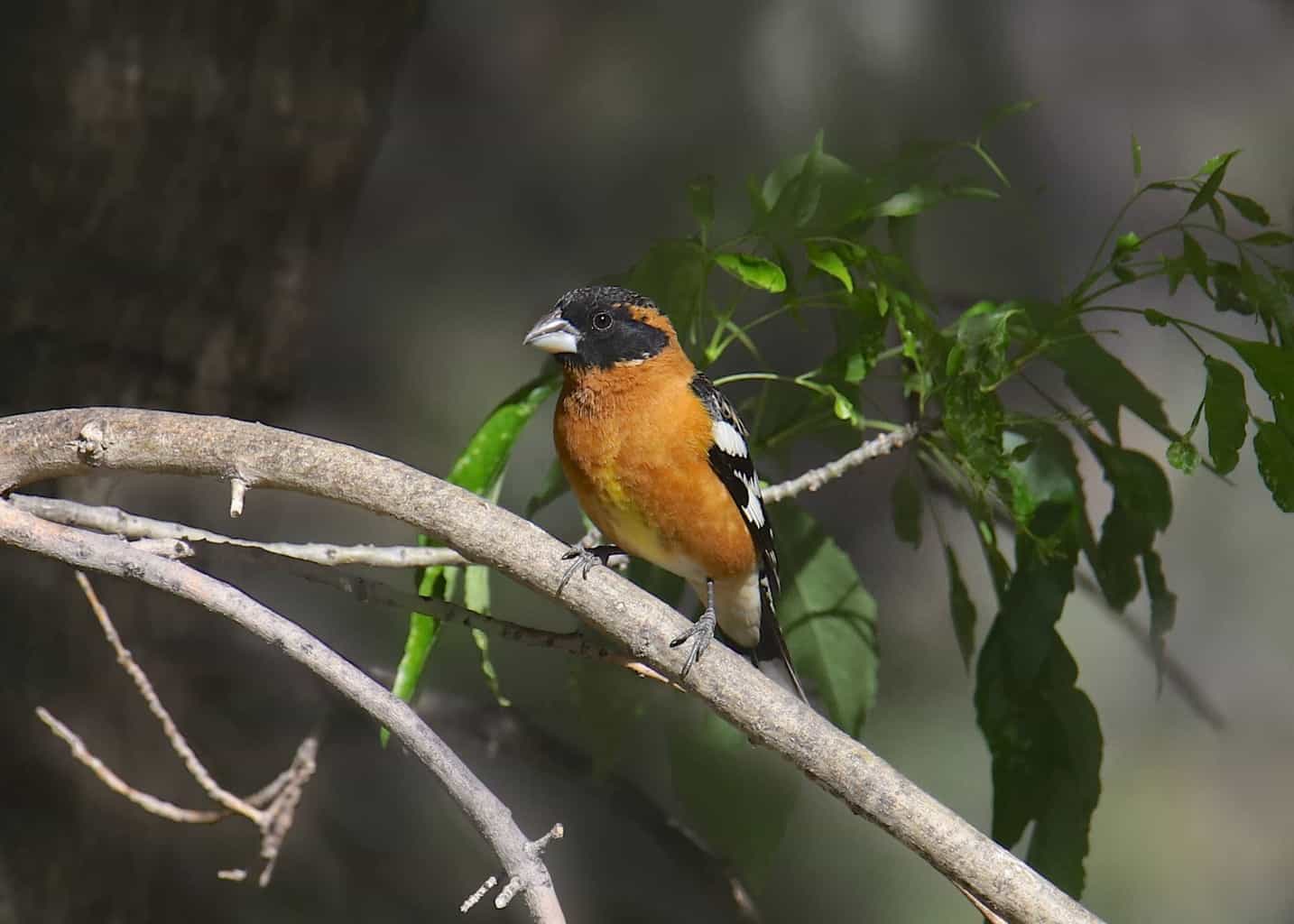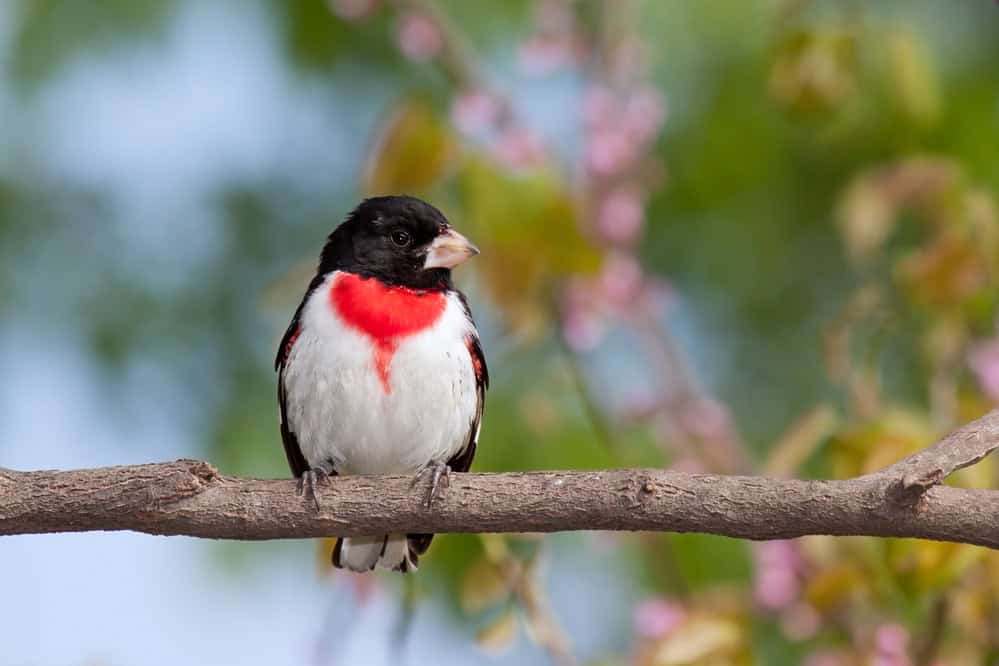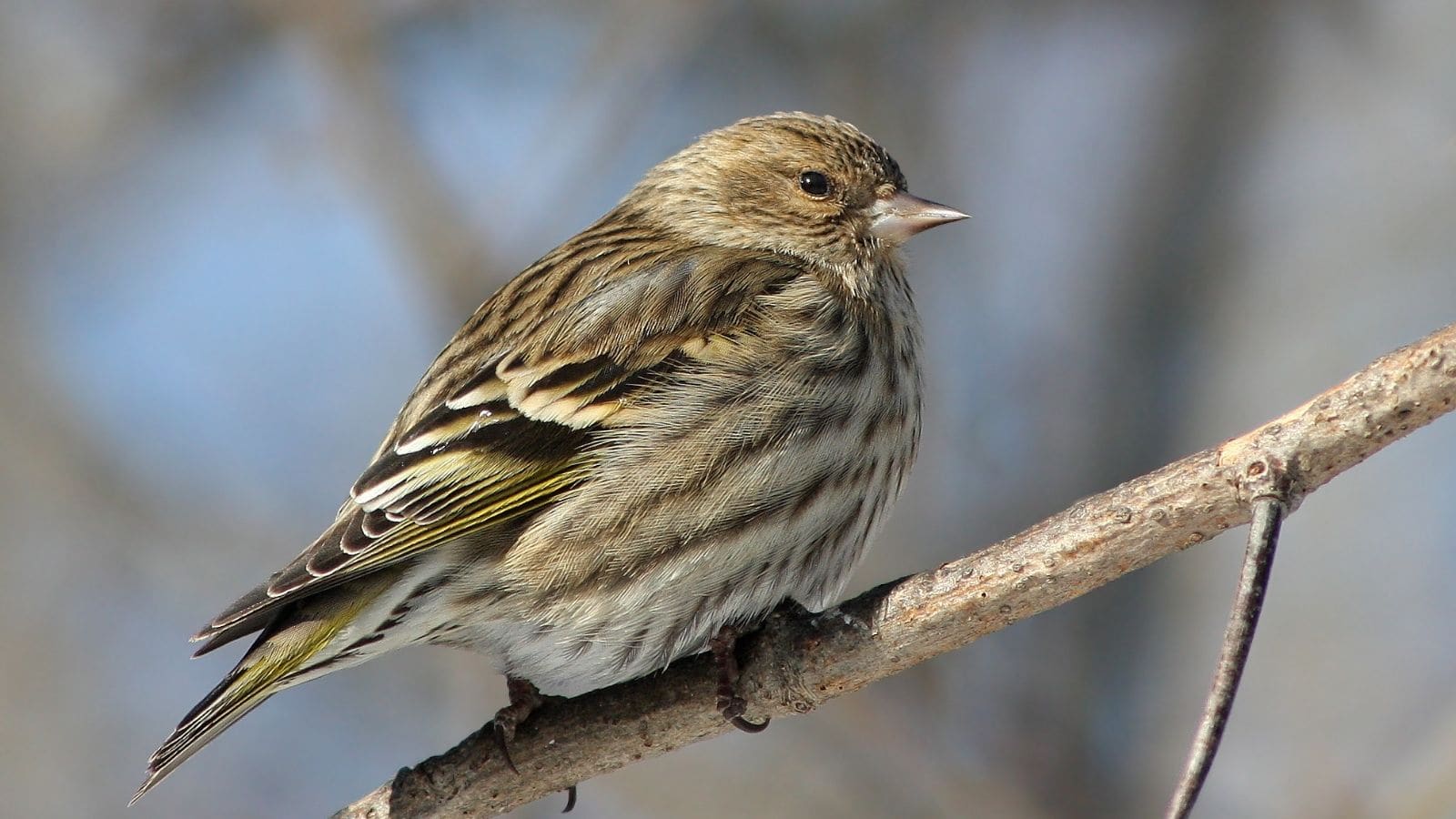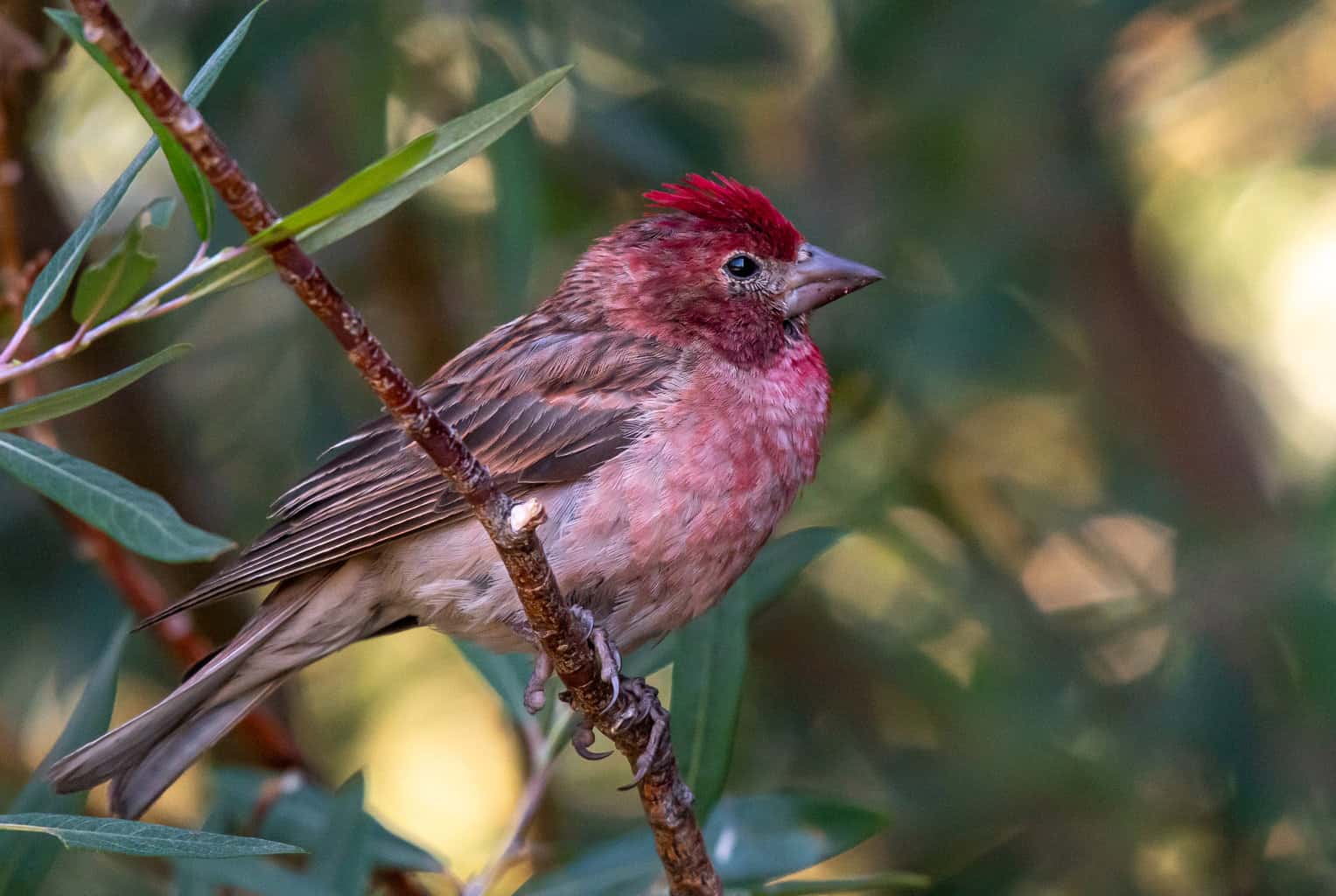Texas has a reputation as a land of herding, agriculture, and some seriously hot summers. As it stands, it’s also a lovely state for spotting up to 11 finch species.
Finches are delightful songbirds that usually prefer to live in forested or shrubby environments. While Texas is just 38% forest, this bird species also happens to be rather adaptable!
Whether you live in Texas or plan on visiting, this state is an underrated bird-watching haven. I’ll help you spot 11 common and not-so-common finch species with tips and fun facts.
Black-Headed Grosbeak

- Species Name: Pheucticus melanocephalus
- Length: 18 cm to 19 cm
- Weight: 34 grams to 48 grams
- Wingspan: 32 cm
This stunning finch has coloration that makes it look permanently autumnal. It’s a fitting color since these birds usually show up in Texas during migration, just before winter hits.
Appearance
The male black-headed grosbeak has a bold black head, orange body, and black wings. They have a spackle of white along their wings with a gray bill.
The female black-headed grosbeak looks similar to the male but with a lighter tan-yellow stomach and gray-black feathers.
Range
These finches much prefer coniferous forests where they can hide or forage for food. They’re also keen on finding a water source, particularly in a hotter state like Texas.
Diet
These beautiful finches have a pretty varied diet, even for the finch family. They’ll eat berries, seeds, and insects as well as snails.
You’ll have an easy time attracting black-headed grosbeaks to your backyard bird feeders. Not only do they love sunflower seeds, they sometimes visit nectar feeders, too.
Birdsong
This finch has a very pleasant warble that sounds like cher-weer-err, sometimes repeating and other times ending sharply.
Fun Fact
I won’t lie, this fun fact blew me away. The black-headed grosbeak has such a tough stomach it regularly eats the monarch butterfly, which is poisonous!
Rose-Breasted Grosbeak

- Species Name: Pheucticus ludovicianus
- Length: 18 cm to 22 cm
- Weight: 35 grams to 65 grams
- Wingspan: 29 cm to 33 cm
This fancy bird always comes dressed to impress. While they usually show up in western Texas during migration season, they’re well worth the journey.
Appearance
The male rose-breasted grosbeak has a vivid red streak going down his chest. The rest of his body is black with a white belly and white wing bars.
The female rose-breasted grosbeak looks so different that some bird watchers believe her to be another species. She has a light brown body with a white belly and long white brow stripe.
Range
Expect to see these birds wherever there are shrubs or forests. These environments enable them to get a well-rounded diet as well as hide from predators.
While southeast Texas is more forested, you’ll still have an easier time seeing them in the west due to migration. Still, it doesn’t hurt to keep an eye out!
Diet
These birds eat plenty of insects, seeds, and fruits. They also enjoy a little nectar from time to time.
You might be able to convince a few birds to stop migrating with fresh sunflower seeds. Since they’re stocky birds, a platform feeder is more accessible than a tube feeder.
Birdsong
The rose-breasted grosbeak has quite a lovely call. They let loose long, sweet warbles with rise-and-fall notes.
Fun Fact
Rose-breasted grosbeaks are so fond of shrubbery that you’ll increase your chances of attracting them by planting a few. Try blackberry or elderberry to create a more enticing backyard feeder experience.
Purple Finch

- Species Name: Haemorhous purpureus
- Length: 12 cm to 16 cm
- Weight: 18 grams to 32 grams
- Wingspan: 22 cm to 26 cm
Although the house finch has muscled them out of many territories, the purple finch still crops up throughout the state.
Appearance
Male purple finches are charming with their raspberry red head and back. They have brown wings, a pale bill, and a rounded body.
Female purple finches are sparrow-like with their mottled brown and white coloring. However, they have thick, white eyebrows rather than black eyebands.
Range
The purple finch isn’t the most common sight in Texas, but you’ll still see a few in the western portion of the state during breeding season.
These finches generally prefer coniferous forests and shy away from heavily populated urban areas. However, they sometimes show up in quieter spots like parks or suburban neighborhoods.
Diet
Purple finches are diverse in their feeding habits, sometimes flitting between trees and other times foraging on the ground. They eat a mixture of berries, seeds, and insects.
Fortunately for the homebound birdwatcher, they won’t miss a chance to visit a well-stocked bird feeder. Try attracting them with black oil sunflower seeds or a nyjer feeder, specifically.
Birdsong
You’ll recognize the purple finch’s dynamic warble very easily. They let out a delicate chwer-chwer-chr with long pauses in between.
Fun Fact
Purple finches and house finches look quite similar at a glance. Remember that male purple finches have reddish backs, while male house finches have brown backs.
Evening Grosbeak

- Species Name: Hesperiphona vespertina
- Length: 16 cm to 22 cm
- Weight: 38 grams to 86 grams
- Wingspan: 30 cm to 36 cm
A less common sight in Texas, this is one finch you still don’t want to miss. Their splashy coloration makes them look like a parrot at a glance!
Appearance
The male evening grosbeak stuns with his yellow feathers, black wings, and large white wing bars. They have a bold yellow eyebrow and a large, pale bill.
The female evening grosbeak looks similar to the male but with more gray than yellow. She’ll often have a lovely ring of yellow around her neck.
Range
Despite their love of colder environments, even these finches can’t resist the lure of The Lone Star State. Expect to see glimpses of this finch in the northeast and the northwest during nonbreeding season.
Evening grosbeaks are interesting in their range, moving from coniferous forests to vast mountains. Texas boasts several famous mountain trails and national parks you should check out for prime birdwatching opportunities.
If you’re not a fan of hiking and camping, you’ll be glad to know they love backyard feeders, too.
Diet
Evening grosbeaks eat a classic finch diet of berries, seeds, and insects. However, they sometimes nibble along the ground for bits of gravel and salt.
You can attract a few to your backyard with sunflower seeds. However, remember these stocky birds need a platform feeder to support their weight.
Birdsong
These finches put most of their effort into their appearance – their songs are minimalist and brief. Expect to hear a few brief chirps that sound like cheer or chee.
Fun Fact
The male evening grosbeak is a dutiful contributor to the family, helping incubate eggs and feeding chicks once they hatch.
American Goldfinch

- Species Name: Spinus tristis
- Length: 11 cm to 13 cm
- Weight: 11 grams to 20 grams
- Wingspan: 19 cm to 22 cm
Compared to the first few finches on the list, the American goldfinch is an accessible finch for most birders. They show up all throughout the state in their characteristic chatty flocks.
Appearance
The male American goldfinch is quite handsome with his lemon-yellow plumage, black wings, and white wing bars. He has a black patch on his head, a black tail, and a bold yellow-orange bill.
However, this yellow color is restricted to mating season. Their coloration will soften to an olive or tan color once it ends.
The female American goldfinch looks similar to the male during non-breeding seasons. The biggest difference is her lack of a black head patch.
Range
These finches show up during non-breeding season, though a few stay year-round in the eastern part of the state. You can see why they’re so at home in Texas thanks to the state’s spacious landscape.
American goldfinches enjoy a well-tended natural habitat — think wide, open country with plenty of shrubs and weeds. However, they’ll sometimes flock to coniferous forests as well as people’s overgrown backyards during winter.
Diet
While American goldfinches eat the occasional insect, they much prefer vegetation. Expect to see them foraging for ragweed, dandelion, and thistle.
They also enjoy berries and maple sap. If you want to attract them to your feeder, make sure to use plenty of fresh nyjer seed.
Birdsong
This finch’s song is sharp and sweet, composed of repetitive chweet-chweet-chweets and warbles.
Fun Fact
The American goldfinch goes by a few different names in North America – the willow goldfinch and the eastern goldfinch.
Lesser Goldfinch

- Species Name: Spinus psaltria
- Length: 9 cm to 12 cm
- Weight: 8 grams to 11 grams
- Wingspan: 20 cm
You don’t get much tinier in the finch family than the lesser goldfinch. They sometimes get confused with the American goldfinch, but their bolder coloration sets them apart.
Appearance
The male lesser goldfinch has a striking black body with a yellow stomach and white wing bars. His light gray bill and gray legs make him stand out despite his tiny size.
The female lesser goldfinch has a light olive-yellow body with gray-brown wings and a pale gray bill.
Range
These finches show up in southern Texas year-round, but further up north during breeding season. They love shrubby, weedy fields and tend to steer clear of more densely packed pine forests.
Lesser goldfinches are a common sight at backyard bird feeders and will regularly bring friends.
Diet
Weed seeds are the preferred food of lesser goldfinches, but they’ll never turn down a bird feeder. Use a thistle sock feeder and keep it freshly stocked.
Birdsong
Their birdsong is lovely to listen to with their chee-er-chee-er warbles and chi-chi-chi notes. They’ll sometimes chatter without pause.
However, you may have a hard time identifying them sometimes due to one little feature…
Fun Fact
Lesser goldfinches are sometimes difficult to identify by their birdsong due to their mimicry habits. Not only do they imitate other birds, they’ll even imitate squirrels!
Pine Siskin

- Species Name: Spinus pinus
- Length: 11 cm to 14 cm
- Weight: 12 grams to 18 grams
- Wingspan: 18 cm to 22 cm
Another common finch in Texas is the aptly named pine siskin. These birds prefer to stick to coniferous forests where they can forage for their favorite food.
Appearance
The male pine siskin boasts a dappled yellow-brown body with yellow breasts and streaked brown wings. Interestingly enough, they have a slimmer conical bill than most finches.
The female pine siskin looks almost identical to the males. They have slightly less yellow, but don’t be hard on yourself if you still confuse them.
Range
Pine siskins are fond of both coniferous and deciduous forests where they can forage for pine seeds in peace. However, they’ll still visit forested areas near suburban neighborhoods or well-tended parks.
Occasionally, you’ll find pine siskins foraging on the ground or by roadsides for a little salt.
They usually show up in northern and eastern Texas during non-breeding season. They’re more scarce in the southern portion of the state.
Diet
Pine siskins are fond of seeds and various plant materials, but they’ll eat the occasional spider. They round out their diet with flower buds and road salt.
You’ll have a higher chance of attracting these birds to your feeder during the winter. Use unshelled sunflower seeds to accommodate their smaller beak.
Birdsong
These birds sound distinctive from most finches with their strained tzweeeee. They’ll have long pauses in between and will occasionally do a double tzwee-tzwee.
Fun Fact
Pine siskins have a massive range stretching from Alaska all the way down to Texas.
Red Crossbill

- Species Name: Loxia curvirostra
- Length: 14 cm to 17 cm
- Weight: 40 grams
- Wingspan: 25 to 27 cm
These finches are a little trickier to spot in Texas since they prefer colder, heavily forested environments up north. However, patient birdwatchers will be rewarded with a unique sight.
Appearance
The red crossbill has a fascinating appearance with its crossed beak. Males have red or orange-yellow bodies with brown wings and dark legs.
The female red crossbill usually has a brown body with hints of yellow-orange. They also have the same criss-crossed beak.
Range
Crossbills developed their beak shape to better dig into cones and pull out the seeds. As such, they stick to coniferous forests with pine trees or spruce trees.
However, they’re adaptable enough to venture outside dense vegetation when food stores get scarce. You may glimpse them in northern Texas, particularly during winter (and if you keep your feeder stocked).
Diet
Red crossbills depend on conifer seeds for the majority of their diet. Stock up your backyard bird feeder with fresh sunflower seeds during the colder months to bring them over.
Birdsong
The red crossbill’s song is as distinctive as their appearance. Expect a bright, metallic chwee-chwee or chi-a chi-a.
Fun Fact
The red crossbill looks similar to a parrot, doesn’t it? Turns out they have a subspecies called the parrot crossbill.
Blue Grosbeak

- Species Name: Passerina caerulea
- Length: 14 cm to 19 cm
- Weight: 26 grams to 31 grams
- Wingspan: 26 cm to 29 cm
This stunning finch is a little rarer in Texas due to its migration pattern, but I can’t recommend it enough. It has one of my favorite colorations of any finch.
Appearance
The male blue grosbeak has a sapphire blue body with brown and black wing bars. The tips of his wings have hints of white.
The female blue grosbeak is just as beautiful, boasting light brown and gray coloration with a blue rump.
Range
These finches enjoy the classic Texan range, often diving in and out of shrubbery, fields, and hedgerows. They usually show up in the state during the breeding season, then promptly migrate elsewhere.
Diet
Unlike most finches, blue grosbeaks generally prefer to eat insects. However, they’ll still eat the occasional seed or fruit when the pickings are slim.
They prefer backyard bird feeders that replicate their favorite shrubby environments. Stock up on sunflower seeds and place your bird feeder next to shrubs or overgrown trees.
Birdsong
Blue grosbeaks have a characteristic warble chwee-er-ee-er-ee, often with long pauses in between. This warble will sometimes change in pitch but usually rises and suddenly drops.
Fun Fact
While blue grosbeaks will sometimes forage in flocks, it’s not uncommon for them to fly solo.
House Finch

- Species Name: Haemorhous mexicanus
- Length: 13 cm to 14 cm
- Weight: 16 grams to 27 grams
- Wingspan: 20 cm to 25 cm
Last but not least, we have the widespread and adaptable house finch. These social birds are the types of finches to show up just about everywhere in the state of Texas.
Appearance
The male house finch has a reddish head with a brown, streaked body. He has a pale bill, but dark legs.
The female house finch lacks the red plumage in favor of uniform brown and white streaky feathers. They look a little similar to a pine siskin.
Range
These birds are comfortable in just about any environment. You’ll easily find them in most of the state year-round, though they’re more scarce in eastern Texas.
House finches regularly visit gardens, backyards, and suburban neighborhoods for nesting materials and food. They’re not shy around people, so you won’t have to get too clever to invite them over.
Diet
House finches eat weed seeds, insects, and berries. You’ll create an irresistible backyard environment if you stock up your feeder with millet and black sunflower seed.
Birdsong
House finches have a sweet and lilting warble that varies dramatically. You’ll also hear the occasional sudden, swooping trill.
Fun Fact
While these finches are cute, they display aggressive behavior. House finches are territorial birds who often muscle out purple finches and house sparrows for feeding rights.
Cassin’s Finch

- Species Name: Haemorhous cassinii
- Length: 16 cm
- Weight: 24 grams to 26 grams
- Wingspan: 25 cm to 27 cm
If you’re up for a birdwatching challenge, the Cassin’s finch is your bird. These species of finches don’t show up in the state often due to their wide migration route.
Appearance
The male Cassin’s finch has a blushing red head, a light brown body, and a pale stomach. You’ll notice they have a little fringe along their forehead that looks like a puff of hair.
The female Cassin’s finch has a brown and white speckled body with a pale bill. She has a characteristic white streak along the side of her head.
Range
These migratory birds generally prefer to nest in forested areas, particularly if they’re nestled in mountain ranges. However, they’ll drift down to forest edges and even visit backyards for a little extra food.
You can consider them winter birds, as it’s more common to see these finches once it gets cold.
Diet
The Cassin’s finch eats a variety of seeds, berries, and tree buds. When their food sources run low, they’ll visit backyard feeders for an easy meal.
They love sunflower seeds, but are more likely to visit if your backyard has a few mulberry shrubs.
Birdsong
These finches have a watery-sounding warble, not sounding quite as sharp or metallic as other finches. You may hear a few soft, soothing trills.
Fun Fact
What’s the most suitable nesting spot for this adorable finch? The Cassin’s finch prefers to breed at higher elevations, even reaching heights of 10,000+ feet.
The Lone Star State’s Herding Country Is Fantastic for Birdwatching
Texas may be best known for cow herding and mountain trails, but it’s actually a prime spot for birdwatching. The state’s sheer size and ecological diversity mean finches are right at home.
Most of these finches have no trouble showing up to backyard bird feeders, so homebody bird watchers are in good hands. If you’re eager to check out national parks or hiking trails, though, keep an eye out for the elusive evening grosbeak.
Curious to learn what other bird species you can find? Our guide on birds in Texas will help you spot woodpeckers, jays, and more.

